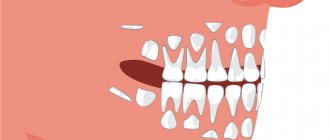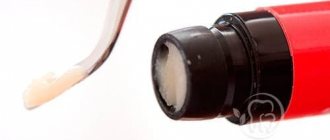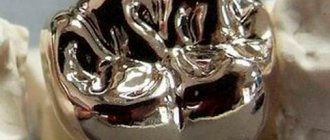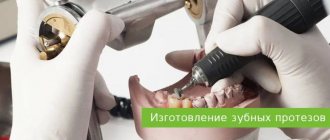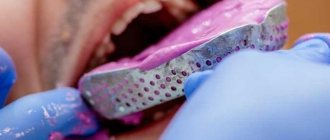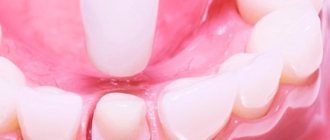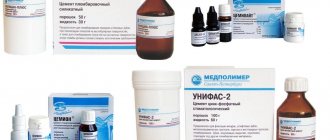- Materials in dentistry
- Therapeutic materials
- Surgical materials
- Orthopedic materials
- Types of materials for restorations
- Metals
- Alloys
- Noble metals
- Base metals
The use of innovative materials and equipment in prosthetics has allowed this dental service to reach a new level.
In order for a specialist to provide high-quality treatment, there is a huge selection of materials and tools on the market aimed at improving patient comfort. High-quality materials for prosthetics and dental treatment play a huge role. At the same time, one should not forget about the professionalism of the specialist himself who will carry out this procedure. This reduces the risk of pain and ensures that the manipulations performed will bring the desired effect, and your teeth will be healthy for a long time.
Modern means in dentistry can reduce the likelihood of relapses and inflammatory processes after treatment. In our country today, the level of services is approaching world leaders.
All this became possible thanks to the use of the latest drugs and tools that allow us to provide medical care.
Therapeutic materials
One of the most popular manufacturers of therapeutic consumables is the Ivoclar Vivadent brand. Today the company produces a large number of dental materials used in various fields. Purchasing a high-quality product can guarantee the creation of the best aesthetic effect, which makes it possible to satisfy the needs of the patient and the doctor.
Special optimized technologies are used to develop composites and filling materials. With their help, you can carry out direct dental restoration.
For direct placement of fillings on teeth, a light-curing composite is used.
It is very convenient for processing and has been one of the leading positions in the dental products market for several years.
One of the main characteristics of all filling materials in modern dentistry is their physical properties and reflection properties. Their wear resistance and the possibility of creating natural and highly aesthetic restorations should also be taken into account. All the necessary properties are inherent in products from the world's leading companies. As a result, the dentist is able to create a perfectly smooth restoration.
A set of liquids, which contain various combinations of materials, for fixation is called an adhesive system. It promotes rapid fixation of these materials to hard dental tissues.
Adhesives are used in dentistry to hold various materials together using surface adhesion.
The adhesion procedure itself occurs due to the emergence of molecular bonds. As a result, it is possible to fill all the uneven teeth with this product, which will increase the contact area. It is worth noting their excellent processing using rotary tools.
Using fluoride varnish, it is possible to carry out a procedure to lighten tooth enamel, which allows you to create a white color. This drug was developed specifically to strengthen the surface of teeth. It not only improves the color of teeth and whitens enamel, but also helps strengthen bone tissue. This product protects the oral cavity from the formation of caries.
The dentist uses many available tools during his work. Some of them make it possible to simplify the work of a specialist, others are necessary for carrying out therapeutic or diagnostic procedures. Special equipment is also required that will provide reliable and open access to the patient’s gums and teeth.
One of these means is a retractor, which is also called a mouth dilator. This is innovative equipment that makes it possible to expand the oral cavity and isolate the mucous membrane without causing harm to the patient. As a result, the specialist’s work field expands significantly.
To install temporary fillings, it is necessary to use filling materials that should not cause harm to health. They must have a high degree of plasticity and not dissolve when exposed to food or saliva. Once hardened, it should be possible to easily remove them from the area of caries formation.
What is needed for quality work?
Recently, the requirements for the quality of treatment are constantly increasing, and the level of services is rising. In order to offer the patient effective and painless treatment, it is necessary to correctly select the necessary materials. Therefore, the manufacturer chosen by the doctor plays a special role here.
It is important to understand that cheap products are not always of high quality, and not every client can afford expensive ones. Therefore, the doctor needs to find a middle ground where the price is optimal and the quality is decent.
Surgical materials
Suture material is considered one of the most popular in modern dental surgery.
Moscow companies present a huge number of all types of these products. Currently, these types of materials are divided depending on their resorbable properties. There are also differences in the size, shape and strength of needles and threads.
Popular is the copolymer monofilament monoquick, which is a violet thread that has a short resorption period. A week after implantation, it maintains strength indicators within 50%. After 2 weeks, this figure drops to 20 percent. Can be used as a synthetic analogue of catgut.
Orthopedic materials for dentists
Impression silicone
- This is one of the main consumables for dentists, which is also used for fixing crowns. In Moscow companies you can purchase materials for orthopedic dentistry from well-known global manufacturers. The use of these materials will allow you to achieve the best results and the highest quality in orthopedic dentistry.
One of the types is precision impression materials, which are produced on the basis of C-silicone.
Peculiarities
These materials are considered universal for almost any method to obtain an impression. They can also be used for sandwich technology or making double impressions.
The perfect precision of this type of silicone allows for the reflection of all details and ensures that the resulting impression will have maximum accuracy. At the same time, the cost of production is lower than that of A-silicone. C-silicones contain base and corrective layers, as well as activators.
Advantages
- Increased resistance to disinfectants;
- The strength of the cast and its elasticity;
- Shrinkage varies slightly;
- In operation they are distinguished by simplicity and versatility;
- Low cost.
Dental A-silicones
They are an impression mass that is characterized by dimensional stability and a low level of shrinkage. The hydrophilicity of this type of silicone allows you to create high-quality impressions even if saliva or blood gets into the impression area. Have no by-products during use.
A-silicones are distinguished by the degree of viscosity, which makes it possible to obtain a finished impression using various types of technology. To enhance quality control, the catalyst and material are available in different colors. Once the impression is removed from the mouth, its impression material cannot be deformed.
All materials that are necessary for bite registration with the A-silicone contained in the composition are used for direct application to the rows of teeth. They are easily removed from the mouth and do not get stuck in the spaces between the teeth.
The best-selling glass ceramic in the dental field is IPS e.max CAD. It has earned great popularity due to the flexibility of its application. Suitable for the manufacture of full-anatomical restorations and has high strength values. All this contributes to its use in various fields.
In daily clinical use, this glass ceramic has proven its strength and aesthetic qualities. The material can be used as a means for the production of full-anatomical crowns. In this case, their thickness will be about 1 millimeter, and the fixation procedure is performed using an adhesive technique.
Telio produces most temporary materials widely used in dental treatment. The production includes many solutions for both dentists and dental technicians. The products are suitable for the production of temporary structures installed on implants or in a traditional design. All designs have compatible properties to ensure a reliable connection and match in color.
New types of cements for dentistry have been developed based on polyacrylic acid. This is a fairly new development that allows for adhesive bonding with dental tissues and, if necessary, with the surface of a ceramic or metal prosthesis. The use of glass ionomer cements has made it possible to expand the range of cements used in dentistry. Now some of them are modified with polymers.
Metals
For partial removable prosthetics, for example, in the manufacture of clasp dentures, metal alloys are used. Usually it is an alloy of chromium with cobalt or nickel, but sometimes titanium is used.
The use of metals as a material for fixed prostheses: crowns and bridges is widespread. They are made from precious metals: gold, platinum, palladium or the above alloys. Metals are also used to make inlays.
Metal ceramics
Nowadays, metals and their alloys are used mainly as a framework for metal-ceramics.
Cladding metal with ceramics solves the main problem of metal structures – galvanosis
. Reacting with each other, metals cause a chemical reaction, which is expressed in a metallic taste in the mouth, irritation of the mucous membranes, and burning of the tongue. Ceramic insulates the metal, preventing galvanization. Structures made from noble metals are bioinert and do not cause galvanosis.
The main disadvantage of metal-ceramics: the metal shines through and the tooth does not look natural. In addition, the junction with the gum often turns blue, which spoils the impression of a smile. Therefore, metal-ceramics are preferred to be used on chewing teeth, where aesthetics are not as important as strength.
Metal-plastic
Used for temporary crowns. The base is made of metal, and a plastic overlay is fixed on top. High-quality crowns can last 2-3 years
, but eventually they will have to be changed. They are fragile, easily painted, and cracked.
Ceramics (dental porcelain)
Ceramic products help solve aesthetic problems and reduce the risk of galvanosis. Conventional dental porcelain is too fragile, so technologists have developed innovative materials:
- leucite-based glass ceramics – Empres
s; - glass ceramics based on lithium disilicate – E-max
; - microceramics based on zirconium silicate – Ceramage
.
Dental dentures made of ceramics:
- imitate tooth enamel in color and light refraction;
- do not cause allergic reactions and galvanosis;
- thinner than metal ones, teeth are not sharpened so much;
- do not require depulpation;
- fit tightly to the gums.
Zirconium dioxide
A special feature of zirconium is its hardness. This is the most durable dental composition. Can be used on chewing teeth. Zirconium is an inert material, it is hypoallergenic and does not cause irritation. Products made of zirconium do not conduct heat and cold well; they will help patients with increased tooth sensitivity.
Zirconium dioxide does not transmit light as well as glass ceramics, so it is particularly white. Disadvantages include the ability to wear away antagonistic teeth.
Metal-free compounds are used for the manufacture of bridges, crowns, veneers, and inlays.
Comparison of compositions for fixed dentures
| Functions | Metal ceramics | Metal-free compounds |
| Wear resistance | High | High |
| Life time | 8-10 years[1] | 8-10 years[1], from zirconium - up to 15 years |
| Aesthetics | Metal shines through the ceramic (blue edge at the gum) | Absolute imitation of natural enamel |
| Care | Thorough, with regular professional cleaning | Tight fit to the gum makes care easier |
| Biocompatibility | May cause allergies, galvanosis | Hypoallergenic, bioinert |
| Weight | Massive | Lungs |
The doctor decides what material to use for dentures after examination and collection of information.
- Alekperov R.B. Orthopedic dentist
Question:
Is it true that nylon deteriorates quickly and the prosthesis needs to be replaced?
Answer:
Nylon prosthesis requires careful care using gentle, non-abrasive compounds and a soft brush. If hygiene rules are not followed, the surface of nylon becomes porous and rough. It is not advisable to use such a prosthesis
- Sapronov D.O. orthopedic dentist
Question:
Is ceramic only suitable for anterior teeth?
Answer:
The strength properties of all-ceramic prostheses determine the preferred scope of their application for the frontal zone.
< Previous Next >
Types of materials for restorations
Today, the following main types of materials are distinguished:
- Basic
, they are also usually called structural;
- Auxiliary
.
The first type includes all the materials that are required to create a prosthesis.
Peculiarities
Among the main materials included in this group are glass ceramics, porcelain, plastics and various metals and alloys.
During restoration, it is necessary to achieve rather contradictory qualities. So safety must be combined with strength and aesthetics.
The highest strength indicator is found in metal products. The alloys from which these prostheses are made have the highest strength. They cope well with stress and abrasion. The values obtained will depend on the metal itself. Titanium is considered the best. Its widespread use allows the production of various fasteners and screws.
At the same time, alloys do not have the ability to convey aesthetics, since they do not have transparency. Even if their outer part is covered with cladding, the restoration itself will not look beautiful. Through surfaces with a lower density, metals will be illuminated. These manifestations will be detected with close attention or a certain viewing angle.
Safety in this case will be guaranteed by the use of certain alloys and their grades. They do not cause allergic reactions and there is no release of compounds hazardous to humans.
There is a whole set of parameters inherent in dental materials:
- Ease of processing
. Substances should be selected so that processing is low cost and simple. This will greatly simplify the production of components. But not all metals are susceptible to these effects. For example, the use of titanium will require more powerful equipment, as well as the presence of special installations that will ensure proper cutting conditions.
- Survivability.
All materials do not cause rejection. An exception may be the patient’s individual intolerance;
- Corrosion resistance.
Preservation of all its properties under the influence of food, saliva and other substances.
Metals
This group of elements has a number of distinctive features that set them apart from others.
Among them are the following variables:
- High plasticity rates;
- Lack of transparency;
- With appropriate processing, it is possible to achieve a shiny surface;
- Increased heat conductivity;
- Malleability of elements;
- High electrical conductivity.
These aspects are inherent in all types of metals that have found their use in dentistry. In this case, metals are divided into non-ferrous and ferrous. All ferrous metals are dark gray in color and have a higher melting point and increased density. For non-ferrous metals, the shades depend on the type chosen. They are more ductile and have low hardness.
Non-ferrous metals are also divided into noble and rare earth. There is also a division according to the structure of their crystal lattice:
- The most common is the cubic body-centered lattice;
- Next comes cubic face-centered;
- The next one is close-packed hexagonal.
Alloys
When using a combination of several metals, it is possible to obtain a separate alloy that will have characteristics not inherent in other metals. There are both metallic and non-metallic alloys. If an alloy contains any metal in its composition, then it is classified as metallic.
Alloys are divided into certain subgroups depending on the number of components contained in their composition:
- Binary
– in the case when the composition contains two elements;
- Triple
– if there are three elements.
Alloys using more elements are possible.
There are several scenarios in which atoms inside alloys interact with each other. If a substance has a different grain structure after melting and has these characteristics, then they are usually called mechanical mixtures. Solid solutions arise when particles completely dissolve in each other. It is solid solutions that make up the majority of alloys used in dentistry. These include gold alloys.
The next classification by which the separation is carried out is the melting point:
- Refractory, not classified as noble, have a temperature of more than 1200 degrees;
- Refractory, classified as noble, melt at temperatures up to 1100 degrees;
- Low-melting materials melt at temperatures up to 300 degrees.
Noble metals
The existing ISO standard classifies these alloys as those that contain from 25 to 75 percent platinum or gold. Due to their increased resistance to corrosion, these alloys are very popular.
In order to create a prosthesis, the following types can be used:
- 750 sample - contains 75% gold and has a melting point of about 800 degrees;
- If the composition contains platinum, then alloys are produced with 60 or 75% gold;
- 850 standard, which contains 85% gold. This material is used for the manufacture of systems and cladding for porcelain crowns;
- Fineness of 900 and above, which contains 91% gold. This option is used for casting bridges and crowns.
The melting point of the third and fourth species is 1050 degrees.
All gold alloys are divided into 4 main groups, divided according to their strength from low to ultra-high. Alloys with low and medium strength are suitable for creating inlays with a single surface. High-strength alloys are used to make short bridges, cast pins, onlays and crowns. Ultra-strong alloys are also used for the production of pins, bridges and a number of other elements.
Base metals
Dentists can use various base metals as a basis for the manufacture of certain types of alloys.
In Russia, chromium-nickel stainless steel has found widespread use in the manufacture of prosthetics. At the same time, the nickel contained in its composition is not always biocompatible, which can lead to allergic reactions. In this case, the material can be used to create structures with a cast form. These can be crowns, bridges, clasps and other orthodontic preparations.
Cobalt-chrome and cobalt-chromium-molybdenum alloys are also widely used in dentistry. This group is quite widely used for the manufacture of crowns, bridges and various structures. The material has a fairly simple degree of sheen, which is considered its main advantage. Maximum precision is achieved in the manufacture of components.
The use of titanium is allowed in two possible forms. The first implies its use in its pure form, and the second as part of an alloy. It is suitable for the manufacture of various dental elements. This metal is also widely used for the production of dental instruments. There are several grades of titanium, each of which is intended for specific purposes.
The next way to use titanium is to add it to materials widely used in dentistry. Titanium has a high melting point, so the production of products from it is a rather labor-intensive process. Shrinkage is also observed, which leads to a decrease in the accuracy of the product. The use of vacuum or inert gases allows the error to be reduced to a minimum.
Among the disadvantages of titanium, one can also note its reaction with the mold used for casting. As a result, scale forms on the mold. The fit of the components is deteriorated due to this problem. Modern techniques are constantly expanding the list of components and today it is possible to work with almost any substance.

